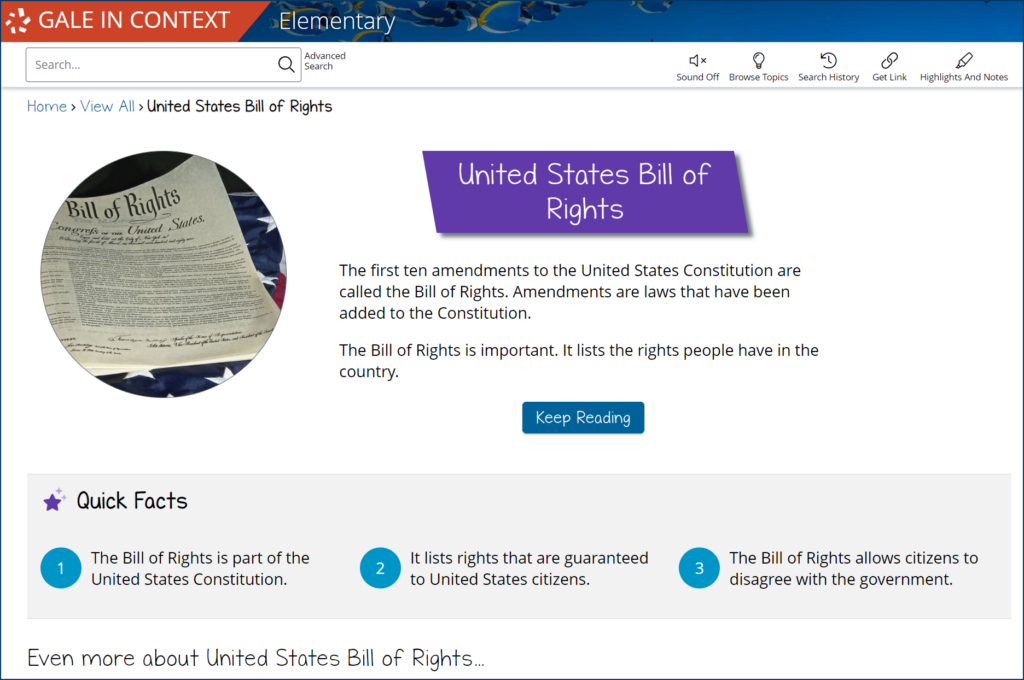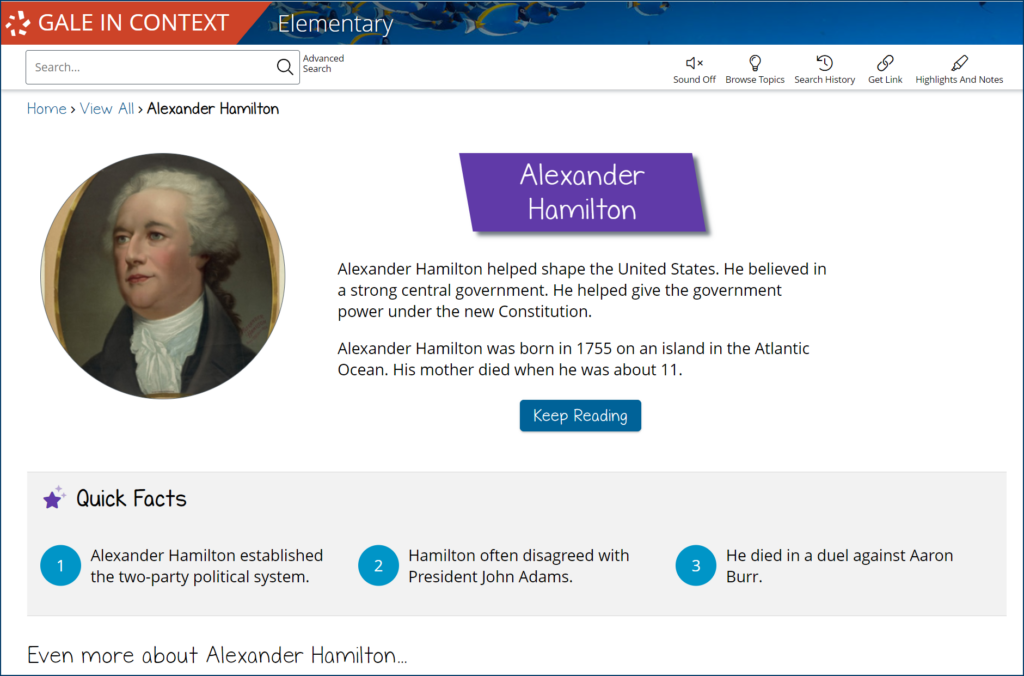| By Gale Staff |
The U.S. Constitution begins with three of the most famous words in our nation’s history: “We the people.” These three words were carefully designed to reaffirm the position of the U.S. government in the hands of its citizens. Despite the Constitution’s clear separation of authoritative powers, early Americans wanted a further guarantee of their personal freedoms. In 1789, to help secure support for the new U.S. government, James Madison drafted a list of modifications to the U.S. Constitution. These 10 amendments would become our Bill of Rights.
On December 15, 1791, the U.S. ratified the Bill of Rights. In recognition of this powerful and lasting symbol, President Franklin D. Roosevelt designated December 15 as Bill of Rights Day in 1941.
To help you create a Bill of Rights–themed lesson plan for the occasion, Gale In Context: Elementary has a special Bill of Rights topic page and ready-made classroom activities to foster student engagement. With this portal, your students can begin to understand their rights as young U.S. citizens and appreciate the history behind them.
Outline the First Ten Amendments
What exactly do the first Ten Amendments (the Bill of Rights) say? What freedoms do they protect? To answer these questions, guide elementary students to Gale’s Bill of Rights summary page. You can adjust the content’s reading level or access text-to-speech software to accommodate diverse student needs. These features ensure all students have an entry point for the topic and feel empowered to learn more.
As a class, read the Ten Amendments aloud and try to summarize each article and the protections it guarantees. For example, the First Amendment mentions freedom of religion, speech, press, and assembly. The Second Amendment protects the right to own a firearm. As you work down the list, define tricky vocabulary (like “militia” or “due process”) and identify ideas that stand out or surprise students.
The Bill of Rights portal supplies links to related topics for further reading into each amendment. Students can quickly access collections on freedom of speech, freedom of the press, and freedom of religion. For such complicated, rich topics, the Bill of Rights is relatively brief and somewhat open-ended, allowing for a range of interpretations. For example, the Second Amendment, while just 27 words, is the subject of ongoing, passionate debate.
Discussion Idea: The First Amendment is one of the best-known articles in the Bill of Rights, but how exactly do its protections apply in real life? What are its limitations? Using Gale resources, read through different free speech–related case studies. Encourage students to begin thinking about the complexities of protected speech.
Discover the Motivation for the Bill of Rights
After reading the Bill of Rights, ask your students to consider why it was necessary. With Gale, your students can dive further into our nation’s history to better understand the country’s early divisions.
Following the U.S. Revolutionary War, the country was challenged to create a new, experimental government structure. Leaders were split between those who favored a centralized, national government (the Federalists) and those who believed in states’ rights (the Anti-Federalists). The United States had only just won independence from the British crown, and people worried that a centralized government could become too powerful.
Before the Revolution, colonists were forced to house British soldiers, pay increasing taxes, and submit to British law without question. Tensions between an authoritarian regime and its subjects, who had no representation in leadership, ultimately led to violence. Having witnessed the consequences of such an imbalance of power, it’s no surprise that early Americans demanded further protections beyond the Constitution. Because of these strong sentiments, U.S. political leaders created the Bill of Rights to assure citizens of their liberties.
Discussion Idea: The Bill of Rights was just a start. Among other things, subsequent amendments helped expand voting rights and prohibited slavery. U.S. law doesn’t limit the number of amendments we can add. Read through the 27 codified amendments thus far. Is anything missing? As a class, brainstorm ideas for new amendments and vote on the favorite.
Meet the Influential Figures Behind the Bill of Rights
Highlight some of the historical figures who helped create and pass the Bill of Rights. Gale In Context: Elementary houses fascinating biographical content on individuals like Alexander Hamilton, who was pivotal to the two-party system that continues to dominate U.S. politics today.
Born into poverty, Hamilton’s natural charm and intelligence helped him become a successful lawyer and politician. Somewhat surprisingly, Hamilton did not support widespread voting rights, believing instead that only landowners should have the right to vote, reasoning that they had the most to lose should the government fail. However, while he pushed back on aspects of the U.S. Constitution, he proved essential to its eventual ratification and was one of its original signatories.
Alongside Hamilton, his colleague James Madison was essential to drafting the Constitution and the Bill of Rights. Madison was born into a wealthy family and had easy access to education. He was a Federalist and a key advocate for the Constitution. While he disagreed with the need for a supplemental Bill of Rights, he ultimately drafted the amendments to appease his opponents and ensure civilian protection.
On the other hand, Patrick Henry was concerned that a centralized government would impede on individual freedoms. He pushed Madison to create the Bill of Rights. Henry’s oratory skills helped spark the American Revolution, famously delivering the timeless words, “Give me liberty or give me death!” He became a significant influence on the country in the following years. As an anti-Federalist, Henry pushed back against Hamilton and Madison’s campaign to ratify the Constitution, eventually forcing the latter to concede and draft the Bill of Rights.
Activity Idea: Imagine how the early political debates might have gone. How did the Founding Fathers, many of whom held oppositional ideals, eventually create the documents that have guided our country for centuries? Act it out! Using one of the activities in Gale In Context: Elementary, assign students to the different characters and have them perform scenes that showcase the debates and compromise behind the U.S. Constitution.
While brief, the Bill of Rights is a dense and powerful document, and its ratification in 1791 was anything but simple. The creation of the Bill of Rights emphasizes the inevitable opposition between a governing authority and its people. After all, political tensions and oppositional beliefs continue to define U.S. society.
Gale In Context: Elementary is a curated database for elementary students. Featuring user-friendly navigation workflows and colorful visuals, our collections effortlessly engage early learners. Busy teachers can trust that the content available through the platform is always age-appropriate, accurate, and customizable to individual needs. Gale In Context: Elementary helps thoughtfully prepare students for more advanced learning, integrating key vocabulary words and exercises to stimulate critical thinking skills. With Gale as your guide, let’s explore the Bill of Rights.
Your Gale subscription can elevate any lesson plan. Not currently a Gale In Context subscriber? Learn more and request a trial today.




